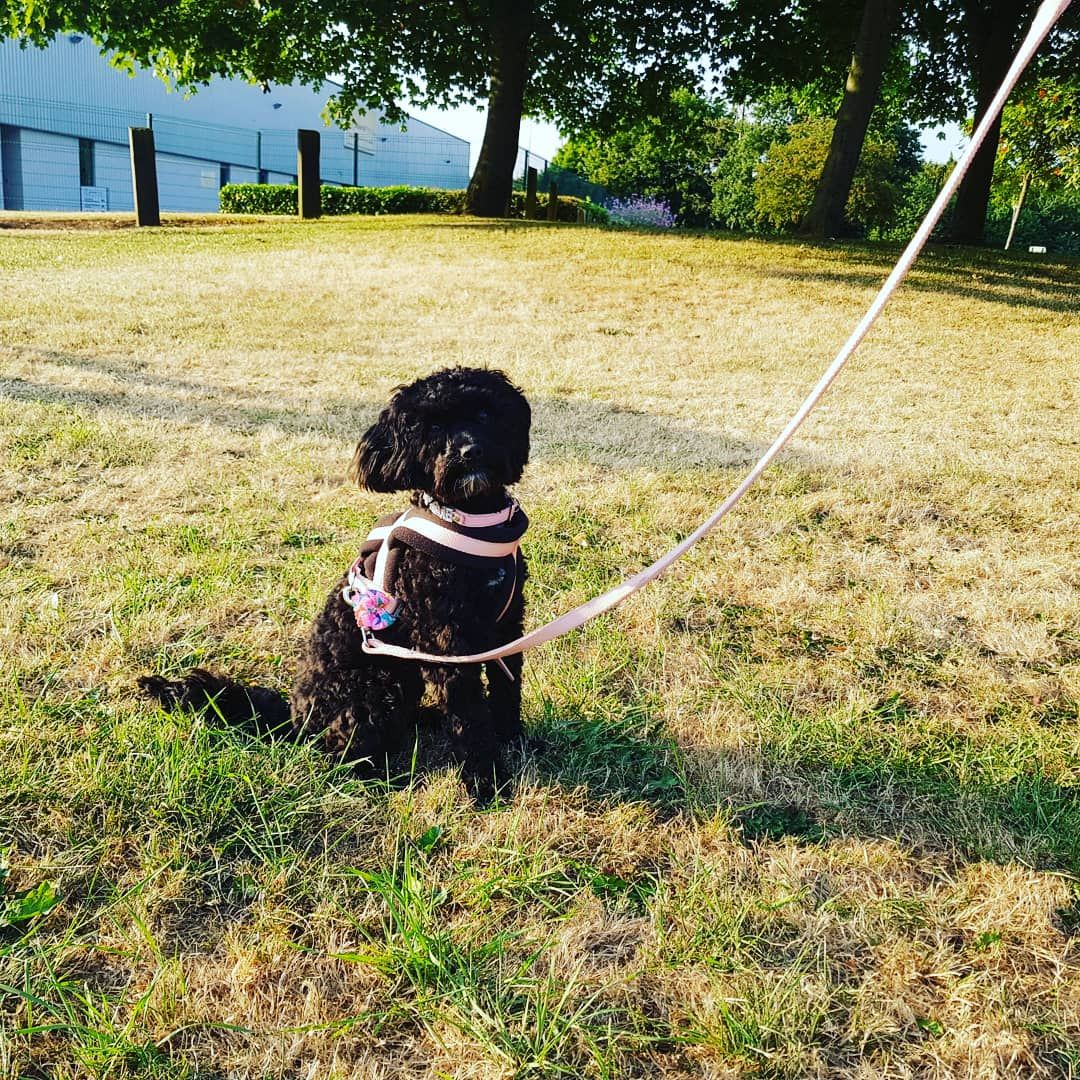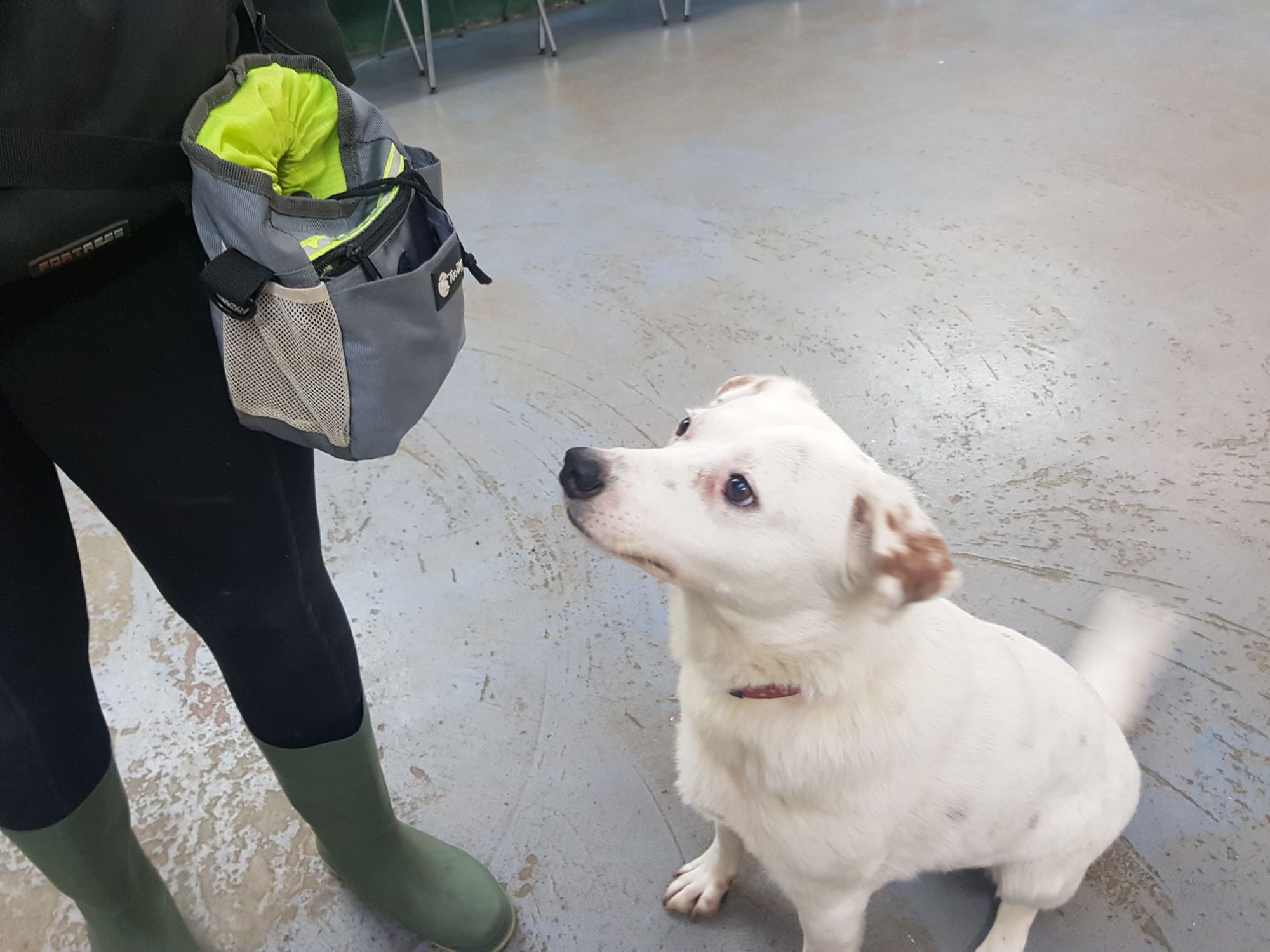Pre-Course Information
Everything you need to know before starting your training with Oakwood.
Below is a list of the type of items suitable to bring to your training sessions at our centre.
Good to bring
Avoid
Walking Equipment
- Plain buckle/clip collar
- Harness
- Regular short lead
- Headcollar
Walking Equipment
- Choke chain / Half-check collar
- Flexi Lead
- Slip Lead
Treats
- Fresh meat or cheese (chicken, ham, sausage, liver, cheddar etc.)
- Primula cheese or liver paste in tubes
Treats
- Dry dog food kibble
- Dog biscuits (e.g. gravy bones)
- Packet dog treats (e.g. cheesy bites, training treats)
Bed
- Cushion
- Towel
- Blanket
- Soft dog bed
Bed
- Hard plastic dog bed
- Kennel
- Living room chair
Toys
- Rope Ragger
- Tennis ball
- Plush toy
- Rubber toy
Toys
- Football
- Squeaky toy
Food Bowl
- Plastic, metal or ceramic
Food Bowl
- Raised food bowl
- Slow feeder
Brush
- Suitable for your dog's coat type
Reward Based Learning!

Motivation
To train effectively, you need something that excites your dog. While dogs are still young, praise from owners can be exciting. However, since most dogs get praise all the time from their owners, something extra is needed to encourage dogs to work hard enough to learn the exercises we want them to do.
Using Treats
Treats should be small so your dog does not become full too quickly. Pieces about the size of a small pea are best. Bring twice as much as you think you will need and always at least 2 different types as your dog is likely to get bored of one type half way through class. See table above for good treats to use.
Don’t let your dog put on weight as a result of feeding lots of treats. Measure the amount of food needed for each day, replace some with special treats for training, and make sure the food and treats form a well-balanced diet (ask your vet for advice).
Your dog needs to be interested in working for the treats you are offering during training, so your dog needs to be hungry during lessons. Don’t feed the last meal before class (e.g. if your class is at 9.30am, don’t feed breakfast. If your class is at 6.00pm, don’t feed your dog dinner etc.). If your dog is not a very hungry dog, don’t feed at all on the day of class.

Using toys
Some dogs work harder for a game with a toy than for food. Soft toys that can be bitten and tugged are best. The disadvantage of using toys is that they are not always easy to use as a lure. You also have to let go of the toy to use it as a reward and get it back again afterwards, which is not always as quick and easy as feeding a titbit. However, if you have a dog that will work for toys and not for titbits, you should use games as a reward for training.
In the mood to learn
As well as being interested in food or wanting to play, your dog also needs to be alert and lively rather than tired. Choose times for training during the day when he has had enough rest, when he does not want to go to the toilet, and when he is not distracted by anything else. If you own a boisterous dog that has lots of energy, try to arrange a vigorous play and free running session in a safe place before training. This will help to ensure that your dog is in a calm, ready-to-learn mood.
Your dog’s name
Your dog will quickly learn to pay attention to you when he hears his name if you say it whenever something nice will happen to him. Your dog will begin to look at you to see what is going to happen when you say it. Once he is responding to his name, you can use it to get him to look at you just before you ask him to do something during the training exercises. There is no need to say his name if he is already looking at you and paying attention – just use it at times when he has his mind on other things.
Reward-based training
The quickest way for your dog to learn an exercise is for you to use food as a guide to encourage him to show the correct behaviour so you can reward it. Timing is very important since the reward needs to be given as soon as the dog does the right thing. This will link the action with the reward in the dog’s mind which will make it more likely that he will show that behaviour again given similar circumstances.
Once the dog is reliably showing the required action, a voice command can be added as a signal to the dog that a reward is now available for performing that action. Since voice commands are quite difficult for your dog to learn (dogs communicate with body language rather than verbal language), hand signals should be given as well. Hand signals can then be slowly withdrawn as the dog begins to understand the voice commands.
As with human learning, repetition and practice is needed to firmly cement the training in the dog’s mind. Dogs take time to learn new lessons, just as young humans do, so don’t expect to train them overnight. You should, however, be making constant, steady progress. If you go wrong and realise you have been rewarding the wrong action, it doesn’t matter. Simply adjust your training procedure and reward the behaviour you do want in future.
Throughout your dog’s education and training:
ENCOURAGE AND REWARD BEHAVIOUR YOU DO LIKE
IGNORE AND PREVENT BEHAVIOUR YOU DON’T LIKE
Learning handling skills
It will take time for you to learn the handling skills needed to make the training work successfully, particularly if this is your first dog. Learning how to hold the titbit, how to use it as a guide, how to hold your dog, how to use the lead to prevent unwanted behaviour, and all the other skills you need to takes practice, rather like driving a car or riding a bike. If you are new to dog training, don’t expect to be good at it to begin with (remember the first time you drove a car or rode a bike). Keep practicing; keep finding out about the correct way to do it, and it will slowly develop.
Different associations
It is important to be aware that when you teach an exercise, your dog will learn a set of associations surrounding that event, rather than just what you are focussing on. If, for example, you always teach your dog to lie down for his dinner in the kitchen, and he begins to lie down in the kitchen when you ask, you may think he knows what the word ‘down’ means. However, you will find that if you take him outside and ask him to lie down, the voice command will not work. This is not because he doesn’t want to respond but because he doesn’t understand. He needs to be taught the same exercise in many different places and is different positions relative to you before he begins to understand that the voice command, heard anywhere, means there is a reward on offer for a particular action.
Random rewards and jackpots
Once a dog has learned to associate a voice command or hand signal with a particular action and is responding reliably every time, the rewards can be reduced. It may seem strange, but scientific experiments have shown that animals will work harder if they are rewarded once for every five tries at random rather than constantly. If you save titbits for the best performances, and give occasional jackpots of extra tasty treats, games and praise, dogs will work much harder than if you reward every time. Make sure your dog has learnt the exercise well before reducing the rewards as, otherwise, he will get very confused.
Keep sessions short
Make sure lessons last no longer than 3 minutes. This will help to ensure that neither you or your dog get tired and you both always leave the session wanting more. Always finish on a success, if necessary going back to something your dog already knows so you can reward well. Practice every day, doing many short sessions throughout the course of the day. Increase the complexity of the exercise gradually, and don’t be afraid to return to an earlier stage and progress more slowly if your dog gets confused. You may find it frustrating if your dog doesn’t progress as you would like or seems to have forgotten what he once knew. If this happens, end the session and walk away before you get cross and put your dog off that exercise. Try to think out a different way to make progress and try something different next time.
Is your dog hard to motivate?
Some dogs can be difficult to motivate. They may not be interested in food or games with toys or may show interest for only a short time. Check that none of the reasons listed below apply to your dog and watch him carefully to find out what makes his tail wag during the day to see what interests him. Try to reserve whatever interests him for training sessions.
- Dog is of a giant breed and doesn’t have energy for very long before wanting to sleep - train in very short sessions when your dog wakes up and is feeling lively
- Dog is unwell - take him to a veterinary surgeon
- Dog plays more with another dog than with humans and so isn’t very interested in people - stop your dog playing with the other dog for a while until you get his interest. Then make sure you continue to play three times longer with him than he plays with other dogs until he is a year old
- Owner has been using the same toys or titbits for a long time and dog has lost interest – change to new, exciting toys or tasty titbits
- Owner is using a boring, monotone voice – praise in a high-pitched, squeaky voice
- Owner is not moving around very much or being exciting – start moving and be exciting!
- Combination of forceful owner and sensitive dog - owner needs to be more gentle and less insistent
- Dog is too scared to eat or play – allow your dog longer to settle into your home and learn to trust the people within it. Train in a safe area that the dog feels secure in
- Dog is full up and doesn’t want titbits – wait until dog is peckish, don’t feed before training.
- Dog has been playing all day – wait until the dog is ready for play
- Dog is tired – wait until dog is rested
If your dog is usually easy to motivate but doesn’t seem interested, it could be because he is anxious about something, such as the arrival of a visitor or is still recovering from car journey, or he could need to go to the toilet.
